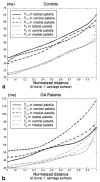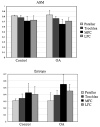Spatial distribution and relationship of T1rho and T2 relaxation times in knee cartilage with osteoarthritis
- PMID: 19319904
- PMCID: PMC2753277
- DOI: 10.1002/mrm.21877
Spatial distribution and relationship of T1rho and T2 relaxation times in knee cartilage with osteoarthritis
Abstract
T(1rho) and T(2) relaxation time constants have been proposed to probe biochemical changes in osteoarthritic cartilage. This study aimed to evaluate the spatial correlation and distribution of T(1rho) and T(2) values in osteoarthritic cartilage. Ten patients with osteoarthritis (OA) and 10 controls were studied at 3T. The spatial correlation of T(1rho) and T(2) values was investigated using Z-scores. The spatial variation of T(1rho) and T(2) values in patellar cartilage was studied in different cartilage layers. The distribution of these relaxation time constants was measured using texture analysis parameters based on gray-level co-occurrence matrices (GLCM). The mean Z-scores for T(1rho) and T(2) values were significantly higher in OA patients vs. controls (P < 0.05). Regional correlation coefficients of T(1rho) and T(2) Z-scores showed a large range in both controls and OA patients (0.2-0.7). OA patients had significantly greater GLCM contrast and entropy of T(1rho) values than controls (P < 0.05). In summary, T(1rho) and T(2) values are not only increased but are also more heterogeneous in osteoarthritic cartilage. T(1rho) and T(2) values show different spatial distributions and may provide complementary information regarding cartilage degeneration in OA.
Figures







References
-
- Brandt KD, Doherty M, Lohmander LS, editors. Osteoarthritis. New York: Oxford University Press; 1998.
-
- Link T, Stahl R, Woertler K. Cartilage imaging: motivation, techniques, current and future significance. Eur Radiol. 2007;17:1135–1146. - PubMed
-
- Gray M, Burstein D, Xia Y. Biochemical (and functional) imaging of articular cartilage. Seminars in musculoskeletal radiology. 2001;5:329–343. - PubMed
-
- Dijkgraaf LC, de Bont LG, Boering G, Liem RS. The structure, biochemistry, and metabolism of osteoarthritic cartilage: a review of the literature. J Oral Maxillofac Surg. 1995;53:1182–1192. - PubMed
Publication types
MeSH terms
Grants and funding
LinkOut - more resources
Full Text Sources
Medical

